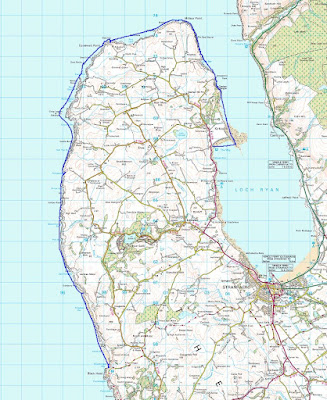
The Rhinns of Galloway really are superb. We launched from Port Logan in the lee of its ancient jetty. In the excellent Scottish Sea Kayaking, Cooper and Reid recommend launching from the fish pond car park which is marked on the map at 096104 (I presume they mean 096410) but access to the beach from here is down a steep wooden staircase with a right angled bend. I would suggest launching from another car park which is not marked on the map but is right beside the beach, 094404, in the shelter of the quay.

Approaching the Mull of Logan you will hopefully find yourself in the strong push of the tide. If not, you might need to brush up on your tidal planning. Close inshore, the north going ebb starts 3 hours before local high water at Portpatrick.

The Mull of Logan is riddled with caves, stacks and channels. It is easy to lose sight of your friends in the maze.

As you can see, David had an enjoyable swim in a cave. A swell shoved him in sideways till his bow and stern got jammed on the narrowing sides. When the swell receded he was left momentarily hanging, until gravity exercised its inevitable effect. A
Palm Stikine dry suit and
Fourth Element Xerotherm Arctic under suit meant that his swim in 9 degree Celsius water was a jolly jape and not a serious incident. This happened just 3km into a 27km day but it did not spoil our day.

In fact we spent so long exploring the Mull of Logan's fantastic arches that the tide turned against us for the last 7km.
The Rhinns of Galloway has tides with overfalls, surf beaches, rocky coves, caves, arches, isolation, ancient castles, quaint harbour villages and towns. It even has excellent sea kayaking pubs and ice cream shops. Tony and I have paddled extensively on Scotland's west coast. A lot of Scottish sea kayakers would say the Garvellachs area is their favourite, but this coastline really beats the islands of Lorn. Paddle it before the crowds arrive!




























